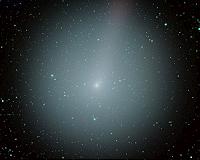 |
Huntsville AL (SPX) Oct 19, 2010 The most famous of all comets, Comet Halley is noted for producing spectacular displays when it passes near Earth on its 76-year trip around the sun. However, you don't have to wait until 2061 to see a piece of the comet - you can do it this very week! Halley's Comet leaves bits of itself behind - in the form of small conglomerates of dust and ice called meteoroids - as it moves in its orbit, which the Earth approaches in early May and mid-October. When it does, it collides with these bits of ice and dust, producing a meteor shower as the particles ablate - or burn up - many miles above our heads. The May shower is called the Eta Aquarids, as the meteors appear to come from the constellation Aquarius. The October shower has meteors that appear to come from the well-known constellation of Orion the Hunter, hence the name: Orionids. Orionids move very fast, at a speed of 147,300 miles per hour. At such an enormous speed, the meteors don't last long, burning up very high in the atmosphere. Last year, the NASA allsky cameras at Marshall Space Flight Center in Huntsville, Ala., and in Chickamauga, Ga., recorded 43 definite Orionid meteors. Most of these appeared at an altitude of 68 miles and completely burned up by the time they were 60 miles above the ground, seen in the graph at right. Even though the peak isn't until October 21, the shower is going on now. The NASA camera systems saw their first Orionid on Oct. 15. Unfortunately, the light from the nearly full moon will wash out the fainter meteors, so expect to see fewer than the 30-per-hour rate you might see under completely dark skies. The good news is that watching Orionids is easy. Go out into a clear, dark sky after 11 p.m. at night - your local time - and lie on a sleeping bag or lawn chair. Look straight up. After a few minutes, your eyes will become dark-adapted, you'll start to see meteors. Any of these that appear to come from Orion will be an Orionid, and therefore represent a piece of Halley's Comet doing its death dive into our atmosphere. Most folks would consider seeing one or two of these a fair exchange for an hour or so of time.
Share This Article With Planet Earth
Related Links Marshall Space Flight Center Asteroid and Comet Mission News, Science and Technology
 NASA Spacecraft Hurtles Toward Active Comet Hartley 2
NASA Spacecraft Hurtles Toward Active Comet Hartley 2Huntsville AL (SPX) Oct 18, 2010 NASA's Deep Impact/EPOXI spacecraft is hurtling toward Comet Hartley 2 for a breathtaking 435-mile flyby on Nov. 4th. Mission scientists say all systems are go for a close encounter with one of the smallest yet most active comets they've seen. "There are billions of comets in the solar system, but this will be only the fifth time a spacecraft has flown close enough to one to snap pictures ... read more |
|
| The content herein, unless otherwise known to be public domain, are Copyright 1995-2010 - SpaceDaily. AFP and UPI Wire Stories are copyright Agence France-Presse and United Press International. ESA Portal Reports are copyright European Space Agency. All NASA sourced material is public domain. Additional copyrights may apply in whole or part to other bona fide parties. Advertising does not imply endorsement,agreement or approval of any opinions, statements or information provided by SpaceDaily on any Web page published or hosted by SpaceDaily. Privacy Statement |